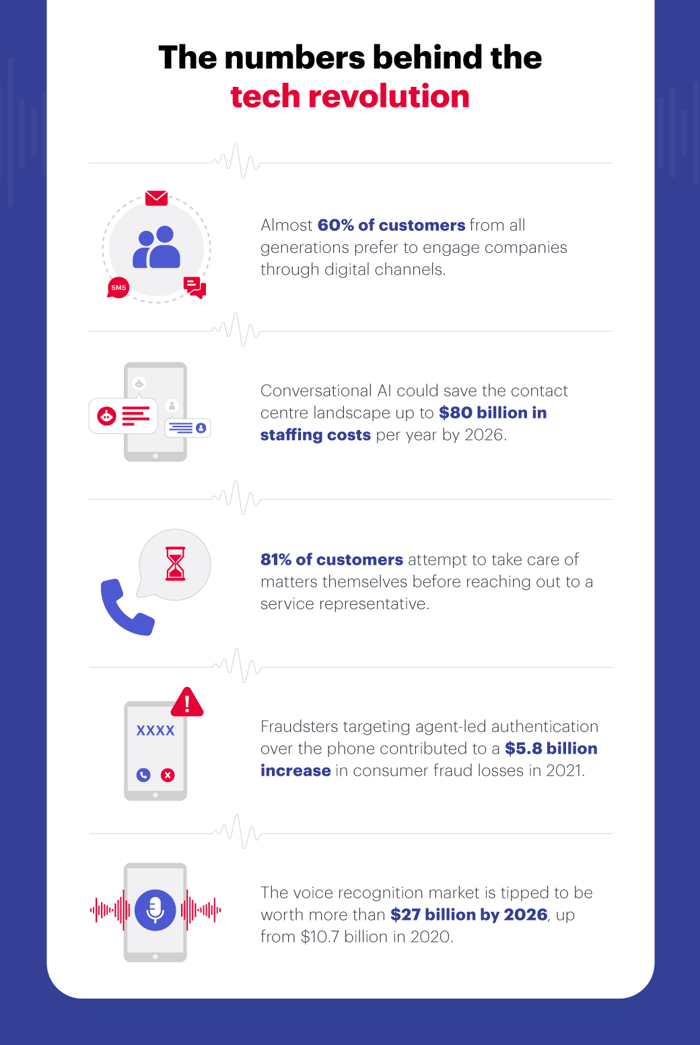Technology is constantly changing the face of contact centres and 2023 will be no different. Where workplace evolution was once a gradual process, the past few years have highlighted the lightning speed that digital innovation can unfold and the risks for organisations that are slow to adapt. The global pandemic forced companies to rewrite the rules of customer engagement that is creating real innovation underpinned by technology that would have seemed the stuff of fiction not so long ago.
In the contact centre space, one does not have to look far to find evidence of the need to not only accept technological change but embrace it. In the wake of the pandemic, almost 60% of customers from all generations now prefer to engage companies through digital channels1, while leading consulting firm Gartner believes conversational AI could save the contact centre landscape up to $80 billion in staffing costs per year by 20262.
The world has demonstrably changed and companies that fail to change with it do so at their own peril. Given that, here are the top contact centre technology trends that will help improve customer experience, increase efficiencies and deliver success in 2023.
Expand CX self-service
It is sometimes easy to forget just how manic those first few months of the pandemic were. As confusion reigned and callers desperately searched for information, contact centres needed to find a way to ensure their human agents were able to focus on emergency issues. The answer came in the form of an investment in self-service tools that help deflect call volumes, with the likes of smart IVRs, online FAQs, automated chatbots and enhanced knowledge bases playing a crucial role in easing the load.
The expansion of self-service is set to continue in 2023 for a couple of reasons. For starters, customers are increasingly keen to use self-service rather than speak with a human agent, as evidenced by a Harvard Business Review study that found 81% of customers attempt to take care of matters themselves before reaching out to a service representative3. It is also a win for contact centres to use such deflection solutions and free up agents for customer interactions that require more focus, empathy and time. Ultimately, it is all about giving people the convenience, control and independence they want – and contact centres the efficiencies they need.
Conversational AI adoption to continue
When it comes to technologies revolutionising the contact centre space, it is hard to go past conversational AI. Its ability to simulate human interaction has helped contact centres vastly improve customer experience and consumers are more than happy to use it, especially if it means they can solve their problems without speaking with a live agent. As one tech expert recently noted, conversational AI’s myriad of functions makes it seem like an iPhone compared to the more limited offerings of IVR.
Contact centres will accelerate adoption of conversational AI during the next year, with customers not only expecting but demanding the more human type of interaction the technology provides. With digital home assistants such as Siri and Alexa becoming a staple of people’s lives, those same people think nothing of engaging with conversational AI when they reach out to a contact centre. Along with allowing greater levels of self-service for the customer, contact centre managers relish the technology’s ability to deliver richer and more relevant insights that ultimately help reduce costs and improve efficiencies.

Another major shift is the interest and adoption of ChatGPT. This incredible technology looks set to create a shift in how customers may look to source information - why go direct to the company when ChatGPT can tell you the answer. The big question to answer is “who owns and authorises the answers?”. The industry is starting to get to grips with this and over the next several years great use cases will start to appear. This is a technology for the medium term that promises much.
Omnichannel integration is a must
Omnichannel has been a corporate buzzword for a few years but 2023 will see it become even more so in the contact centre environment. The modern customer wants to not only be able to engage with brands when and where they want but seamlessly move between platforms and drop in and out of those engagements. That means engaging with contact centres across their medium of choice – be it voice, website, async messaging, social media or SMS – and providing agents with access to customer support data across every brand channel.
Rather than simply being focused on reducing contact centre costs, decision-makers will increasingly broaden their scope to creating an omnichannel approach that drives a consistent customer experience regardless of the channel they use. It is all well and good to offer options such as phone, email and chat but the true value is found when they are brought together in a manner that means customers barely bat an eyelid when moving between them. This means that one interaction from a customer can span multiple channels using each for the type of question/answer that it is best suited to rather than having to stay only in the initiating channel. This will be a year when the ability of decision-makers to keep pace with technologies and channels that customers demand will go a long way to deciding just how far they stay ahead of their competitors – or fall behind.
Focus on performance metrics
Data is the key to improving agent performance, optimising team capabilities and driving customer retention, all of which should be top of mind for contact centre managers. The good news is there has never been more capacity to capture data and deliver the insights needed to stay ahead of emerging trends and make adjustments as needed. Technology that incorporates analytics and illuminating reporting dashboards provides contact centres with access to key metrics such as average handling times, customer satisfaction levels and even the sentiment of callers while on the phone.
In 2023, contact centre executives will look to further invest in technologies that provide them with a combination of real-time and historic data to make better strategic and operational decisions. From identifying additional training needs to spotting opportunities to improve CX and helping address concerns with products and services – and, in turn, facilitate happier customers - performance metrics will be one of the year’s top contact centre priorities.
Voice verification and identification is the future
Between the rising concern of identity fraud and high-profile data breaches, customer security was a burning issue during 2022 and that will not change during the next 12 months. This is especially so for contact centres, with research showing fraudsters targeting agent-led authentication over the phone contributed to a $5.8 billion increase in consumer fraud losses in 2021, a 70% increase on the previous year2. Little wonder that contact centres are rushing to deploy technologies that allow customers to verify their identity without the need to interact with human agents or present any physical material.
Voice verification and identification enables a customer’s voiceprint to be used as the key to their account. Also known as voice biometrics, it works on the premise that, like a fingerprint, every person’s voice is unique and once enrolled in the system can be used to verify their identity in future calls. The simple act of them saying their account or phone number is all that is needed to confirm their identity against their voiceprint. With Statista projecting the voice recognition market to be worth more than $27 billion by 2026 – up from $10.7 billion in 2020[5] – expect more contact centres to introduce or enhance their own capabilities in coming months.
Summary
From conversational AI and self-service to the power of voice verification and identification, the contact centre environment is an incredibly exciting place to be in 2023. Customer experience is primed to be improved, efficiencies are ready to be made and cost savings are well within reach. All it will take is the ability to identify the best tools and solutions to make such benefits a reality and then work with trusted technology partners to implement them.
One company that did just that was a leading Australian retailer that achieved a reduction of up to 30 seconds on its average call handling time during a huge sales event. Discover how utilising artificial intelligence and complex call routing solutions allowed the organisation to handle huge spikes in call volumes.





